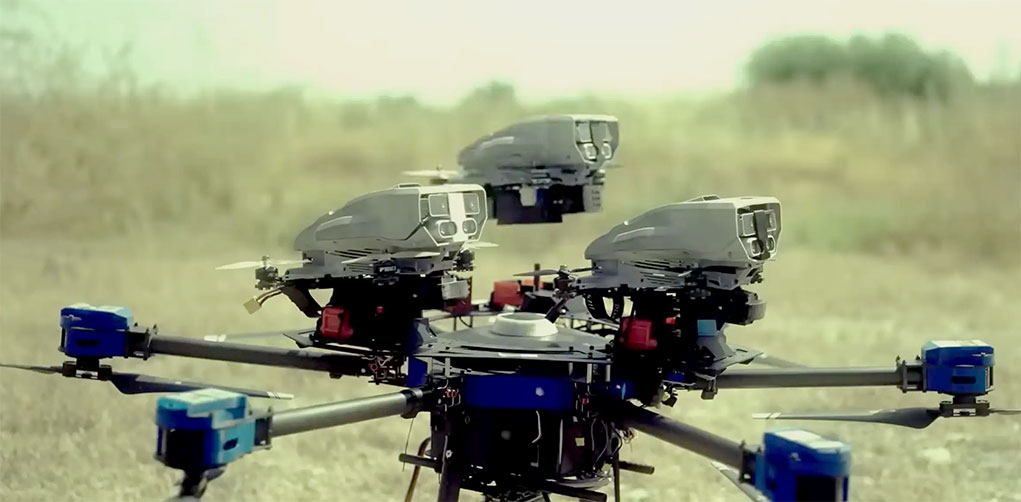Operating drones low above ground and in complex terrain represents unique challenges, as most drone controls are limited to line of sight and uninterrupted satellite-based navigation. To endure in a GNSS-contested environment and operate indoors or underground, standard drones would not operate in such conditions. The drone platforms specially designed for subterranean or indoor environments require unique networking, sensing, navigation, and controls to enable such operations. Since these missions are complex and the drones are small, they are used in mission-specific roles such as autonomous mappers, FPV-operated lead elements, and armed effectors.
RAFAEL’s Magic Fly System
RAFAEL’s Magic Fly is a typical mapper. With a large battery, it is equipped for longer missions. Carrying multiple sensors, it autonomously generates a map of the indoor space. As a robotic teammate, Magic Fly Raven can operate autonomously for 15 minutes in any terrain and in a GPS-denied environment. As a pathfinder, it generates a 3D mapping of the target. With its ATR, it automatically detects potential hostile targets or weapons in its path.
When the team closes in, they release a swarm of Magic Fly Nano. These autonomous flying bots are much smaller than the Raven and can fly through narrow passages. These nano drones have a low acoustic signature, and they are equipped with sensors that extend the Raven’s 3D map with 2D mapping and assist the team in close-quarter battles, enabling the team to establish first contact in multi-story operations. According to visuals released by IDF special operations forces, the system is fully developed and appears to have been used in recent IDF activities.

Elbit Systems’ Lanius
Another drone sensor built for indoor combat is the Lanius, a search and attack system packed into a single platform developed by Elbit Systems. Lanius weighs 1.25 kg and carries a payload of 150 gr. Equipped with AI technology that allows autonomous outdoor and indoor navigation, mapping, obstacle avoidance, scanning of buildings to identify openings, enemy detection and classification, target incrimination by humans and machines, and lethality.
Launched from a larger drone, Lanius can be deployed close to the target and operate inside for seven minutes. It can also be used in an Ambush mode, enabling the Lanius to perch and wait for hostiles to appear.

Xtend’s Indoor Drones
A specialist in indoor drones is Xtend with their Xtender, a miniature drone enabling intuitive indoor control using a hand controller and virtual reality goggles displaying the drone’s view to the remote operator. This multirotor UAS is specially adapted for the indoor environment; as a multi-mission robot, it is equipped with cameras and other sensors for surveillance missions and can carry other effectors, enabling the operator to engage targets.
Like other aerial vehicles from Xtend, the Xtender uses the company’s OSX operating system to implement human-assisted autonomy to fly the mission. Most operations are automated, such as navigation, situational awareness, hovering, and station-keeping. The system enables the operation of several drones simultaneously in a coordinated manner, displaying sensor views from several drones for wider situational awareness.
Xtend offers several models for indoor operations, including the Xtender Mini, built specifically for indoors, the Xtender for indoor and outdoor use with a 1-1.5 kg payload capacity and lethal capabilities, and the Scorpio for indoor and outdoor use.
Robotican’s Rooster
Another indoor drone is the Rooster – a flying multirotor drone encapsulated in a roll cage produced by Robotican. This energy-efficient configuration enables the vehicle to move on the ground and ‘jump’ to maneuver above obstacles, making it suitable for subterranean and indoor operations.
Unlike other multirotor drones, Rooster can silently perch and stare for a long time as an overwatch. Utilizing a mesh radio network, it efficiently operates in communications-denied areas, leveraging seamless relay functions of all network members. Compared to mini and nano drones, which are limited to a few minutes or up to 15 minutes of flight, Rooster can fly for up to 15 minutes and operate for 40 minutes of ground movement.
Developed by Robotican and DDR&D, Robotican also employs the Rooster with Ghost Robotics’ V60 quadruped (legged) unmanned ground vehicle (Q-UGV) in a cooperative mission system, combining a legged robot dog with the Rooster drone.
Further reading:




















